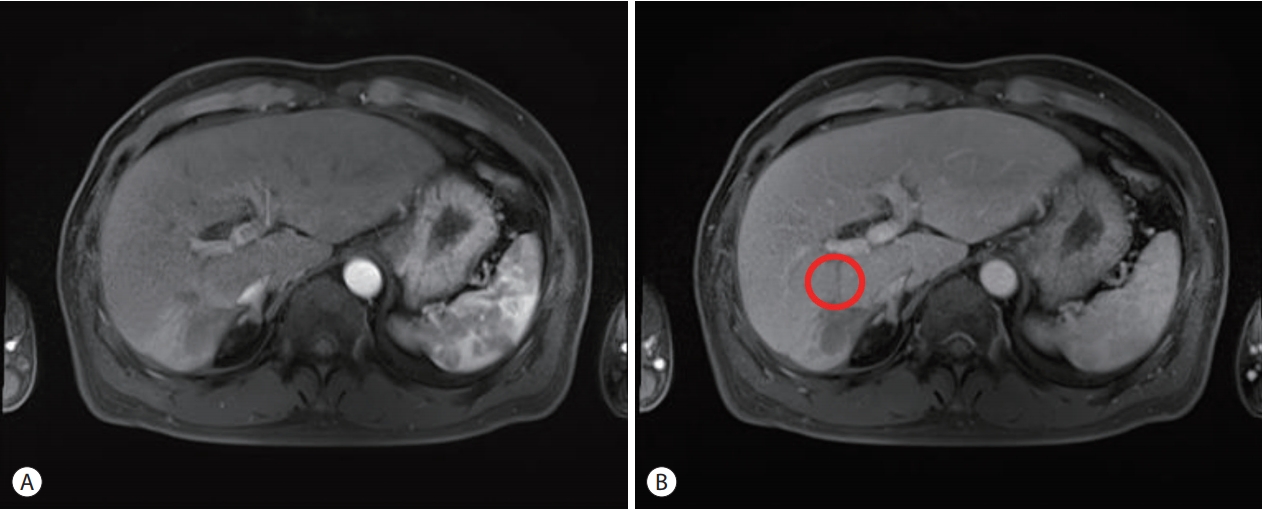Search
- Page Path
- HOME > Search
Case Reports
- Liver Transplantation after Successful Downstaging with Hepatic Arterial Infusion Chemotherapy in a Patient with Hepatocellular Carcinoma with Portal Vein Tumor Thrombus
- Hee Chul Nam, Pil Soo Sung, Ho Jong Chun, Dong Goo Kim, Jeong Won Jang, Jong Young Choi, Seung Kew Yoon
- J Liver Cancer. 2019;19(1):64-68. Published online March 31, 2019
- DOI: https://doi.org/10.17998/jlc.19.1.64

- 3,248 Views
- 58 Downloads
-
 Abstract
Abstract
 PDF
PDF - Hepatocellular carcinoma (HCC) is one of the most common cancers worldwide. The majority of patients with HCC are diagnosed at advanced disease stages with vascular invasion, where curative approaches are often not feasible. Currently, sorafenib is the only available standard therapy for HCC with portal vein tumor thrombosis (PVTT). However, in many cases, sorafenib therapy fails to achieve satisfactory results in clinical practice. We present a case of advanced HCC with PVTT that was treated with hepatic arterial infusion chemotherapy (HAIC) followed by liver transplantation. Three cycles of HAIC treatment resulted in necrotic changes in most of the tumors, and PVTT was reduced to an extent at which liver transplantation was possible. Further studies are required to determine the treatment strategies for advanced HCC with PVTT that can improve prognosis.

- A Case of Liver Transplantation after Combination of Sorafenib and Hepatic Arterial Infusion Chemotherapy in the Advanced Hepatocellular Carcinoma Patient with Portal Vein Thrombosis
- Do Seon Song, Myeong Jun Song, Si Hyun Bae, Jong Young Choi, Seung Kew Yoon, Ho Jong Chun, Dong Goo Kim
- Journal of the Korean Liver Cancer Study Group. 2012;12(1):62-66. Published online February 28, 2012
- 610 Views
- 0 Download
-
 Abstract
Abstract
 PDF
PDF - Hepatocellular carcinoma (HCC) is the third most common malignancy in Korea where chronic hepatitis B virus is prevalent. More than 60-70% of HCC cases are diagnosed at an advanced stage that are not eligible for curative therapy such as surgical resection, liver transplantation, radiofrequency ablation, and percutaneous ethanol injection. According to Barcellona Clinic Liver Cancer (BCLC) staging and treatment, standard treatment of advanced HCC is sorafenib. And there are some reports that hepatic arterial infusion chemotherapy (HAIC) could be a beneficial therapeutic option for patients with advanced HCC. We report a case of advanced HCC with portal vein thrombosis that received liver transplantation after combination treatment of HAIC and sorafenib.

- A Case of Advanced Hepatocellular Carcinoma in Twenties Treated by Multimodality Therapy
- Jang Eun Lee, Na Ri Yoon, Si Hyun Bae, Jong Young Choi, Seung Kew Yoon, Dong Goo Kim, Ho Jong Chun, Byung Gil Choi, Hae Giu Lee, Hong Seok Jang, Chan Kwon Jung, Eun Sun Jang
- Journal of the Korean Liver Cancer Study Group. 2009;9(1):82-85. Published online June 30, 2009
- 489 Views
- 1 Download
-
 Abstract
Abstract
 PDF
PDF - The prognosis of young patients with hepatocellular carcinoma is remains controversial. Here we report a case of advanced hepatocellular carcinoma in twenty, successfully treated with transarterial chemolipidolization (TACL), systemic chemotherapy, radiation therapy and surgical resection. Previously healthy 28 years old woman was admitted for treatment of hepatocellular carcinoma. Abdominal CT showed a diffuse infiltrative HCC involving both lobes with intrahepatic bile duct invasion and pericardial lymphadenopathy. She was treated TAC with systemic chemotherapy and external beam radiotherapy. 6 months after these treatments, main tumor and the pericardial lymph node were decreased in size. And then extended left lobectomy and systemic chemotherapy were done. The pericardial lymph node was markedly decreased. The patient has been followed for 10 months without evidence of regional tumor recurrence.

- A Case of Hepatocellular Carcinoma of Intrahepatic Duct Invasion Treated with Early Surgical Resection
- Woo Chul Chung, Young Min Park, Si Hyun Bae, Jong Young Choi, Doo Ho Park, Dong Goo Kim
- Journal of the Korean Liver Cancer Study Group. 2001;1(1):72-76. Published online June 30, 2001
- 589 Views
- 5 Downloads
-
 Abstract
Abstract
 PDF
PDF - A 40-year old patient with chronic hepatitis B was admitted to our hospital due to right quardrant abdominal pain and jaundice for 2 days. One month ago, he had been treated for acute cholangitis. Total bilirubin was 6.69 mg/dL, AST/ALT level 150/165 IU/L, and AFP 6.7ng/mL. Abdomen CT showed that diffusely irregular tortuous dilatation of IHBD was noted in S 6, more markedly in the peripheral portion, with rather higher density than fluid within lumen, suggesting mucin producing biliary tumor. ERCP demonstrated that a long segment movable filling defect was present at CHD, proximal CBD and posterior right intrahepatic duct. Suggesting sludge and posterior inferior segment of right intrahepatic duct was not visualized with filling defects. At that point we suspected that his diagnosis was cholangiocarcinoma. So we carried out the surgical resection. The pathologic results were hepatocellular carcinoma with bile duct invasion. Because of the incomplete resection of hepatocellular carcinoma, TAC was performed twice during the next 2 months. After then he has been taken care at OPD with good condition. This case shows that hepatocellular carcinoma is early detected by bile duct dilatation on CT and successfully treated by surgical intervention and TAC.


 E-submission
E-submission THE KOREAN LIVER CANCER ASSOCIATION
THE KOREAN LIVER CANCER ASSOCIATION
 First
First Prev
Prev



 Follow JLC on Twitter
Follow JLC on Twitter